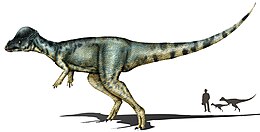User:Augustios Paleo/sandbox
| Alaskacephale Temporal range: Early Maastrichtian,
| |
|---|---|

| |
| Scientific classification | |
| Domain: | Eukaryota |
| Kingdom: | Animalia |
| Phylum: | Chordata |
| Clade: | Dinosauria |
| Clade: | †Ornithischia |
| Clade: | †Pachycephalosauria |
| Family: | †Pachycephalosauridae |
| Genus: | †Alaskacephale Sullivan, 2006 |
| Species: | †A. gangloffi
|
| Binomial name | |
| †Alaskacephale gangloffi Sullivan, 2006
| |
Alaskacephale was a genus of pachycephalosaurid, a group of dome-headed, herbivorous ornithischian dinosaurs, that lived during the Maastrichtian stage of the Late Cretaceous period in what is now northern Alaska. Alaskacephale is one of the few known Arctic dinosaurs and was found in the Prince Creek Formation, which preserves a menagerie of fossils. The only known specimen, a squamosal bone, was found in 1999 and later described in 2005. However, Alaskacephale was not formally named until the next year.
Alaskacephale, due to the lack of fossil remains, is poorly known. Despite this, much of its characteristics such as the presence of bony nodes and structures along the squamosal, prove it was a pachycephalosaur. Later phylogenetic analyses suggest it was a close relative of its southern neighbor Pachycephalosaurus. However, Alaskacephale is distinguished by traits such as two rows of nodes along the squamosal, whereas other pachycephalosaurs bear one row.
It was discovered in the rocks deriving from the Prince Creek Formation, which bears a variety of fossils, many of them similar to other previously known Laramidian taxa. Alaskacephale coexisted with dinosaurs like the ceratopsian Pachyrhinosaurus, ornithopod Edmontosaurus, and tyrannosaurid Nanuqsaurus in additon to mammals like Unnuakomys.
Discovery
In 1999 during an expedition by the University of Alaska, an isolated pachycephalosaur squamosal was unearthed from sedimentary bluffs on the bank of the Colville River in Slope Borough, Alaska. Strata (rock layers) deriving from this area come from the early Maastrichtian-aged (70-69 mya) Prince Creek Formation. The fossil was then deposited in the University of Alaska Museum and described in 2005 by Roland Gangloff and colleagues as belonging to a pachycephalosaurine closely related to, but distinct from, Pachycephalosaurus. However, the next year paleontologist Robert Sullivan described it as a new genus and species, Alaskacephale gangloffi. The genus name comes from Alaska, the state the holotype (name-bearing specimen) was found in, and cephale, from the Greek kephale meaning "head". Its species name is in honor of Roland Gangloff, who described the
Askacephale was named by Robert Sullivan in 2006.[1] The genus name refers to Alaska, where the holotype was discovered, combined with the Greek kephale, meaning head. The species name, gangloffi, honors paleontologist Roland Gangloff. The only known specimen of A. gangloffi is the holotype UAM AK-493-V-001, found in 1999, a nearly complete left squamosal with a characteristic array of polygonal nodes. The dimensions of this bone suggest that A. gangloffi was about half the size of Pachycephalosaurus wyomingensis or three quarters the size of Prenocephale, and about the same size as Sphaerotholus edmontonensis and Foraminacephale.[2]
The specimen was previously described by Gangloff et al. (2005) as an unnamed pachycephalosaurid, possibly a Pachycephalosaurus. Gangloff et al. described the squamosal as having an interdigitated suture with the quadrate, a feature previously described only in Pachycephalosaurus. Sullivan (2006) opined that this "suture" is instead a breakage point in both Alaskacephale and Pachycephalosaurus, so it could not be used to unite the two taxa.
Description
blablba;bla
Classification
Within the tribe Pachycephalosaurini, Alaskacephale is very closely related to Pachycephalosaurus wyomingensis. Below is a cladogram from Evans et al., 2021.[3]
| |||||||||||||||||||||||||||||||||||||
See also
References
- ^ Sullivan, RM (2006). "A taxonomic review of the Pachycephalosauridae (Dinosauria: Ornithischia)". New Mexico Museum of Natural History and Science Bulletin (35): 347–365.
- ^ Gangloff, R.A.; A.R. Fiorillo; D.W. Norton (2005). "The first pachycephalosaurine (Dinosauria) from the Paleo-Arctic of Alaska and its paleogeographic implications". Journal of Paleontology. 79 (5): 997–1001. doi:10.1666/0022-3360(2005)079[0997:tfpdft]2.0.co;2. S2CID 130669713.
- ^ Evans, David; Brown, Caleb M.; You, Hailu; Campione, Nicolás E. (2021). "Description and revised diagnosis of Asia's first recorded pachycephalosaurid, Sinocephale bexelli gen. nov., from the Upper Cretaceous of Inner Mongolia, China". Canadian Journal of Earth Sciences. 58 (10): 981–992. Bibcode:2021CaJES..58..981E. doi:10.1139/cjes-2020-0190. S2CID 244227050.
